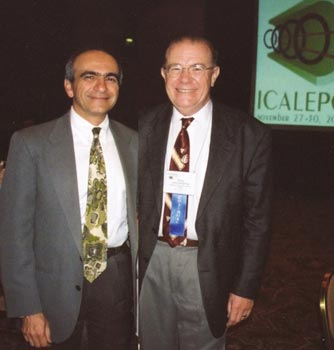Control systems engineering in particle physics laboratories has many applications, as the ICALEPCS 2001 conference showed. Axel Daneels and Rusty Humphrey report.
The 8th biennial International Conference on Accelerator and Large Experimental Physics Control Systems, ICALEPCS 2001, was held in San Jose in November and hosted by the Stanford Linear Accelerator Center (SLAC). Some 270 control systems specialists took part, with around 120 staying on for three workshops covering databases, experimental physics and industrial control systems (EPICS) and automated beam steering.

The ICALEPCS conferences attract participants from a broad range of subject areas. As well as particle accelerators and detectors, other large facilities such as telescopes, fusion devices and nuclear reactors are also represented. Both hardware and software aspects are covered. The 2001 meeting saw participants coming from Africa, the Americas, Asia and Europe, representing 62 laboratories and seven companies. With such a broad base, focused workshops traditionally follow the conference. Last year, Roland Müller from Berlin’s BESSY synchrotron laboratory organized one for the international accelerator database group, Greg White of SLAC convened another on automated beam steering and shaping, and Bob Dalesio of the Los Alamos National Laboratory organized a third on EPICS.
Widening applications
The broadening range of applications of control systems for large-scale facilities was demonstrated by the large number of first-time contributions from non-accelerator facilities. From the field of nuclear fusion, the laser-driven approach was represented by a talk on the Lawrence Livermore National Laboratory’s National Ignition Facility (NIF) project, while the magnetic confinement approach was represented by Princeton’s National Spherical Torus Experiment (NSTX). Talks on astronomy covered the European Southern Observatory’s Very Large Telescope (VLT) and the VISIR mid-infra-red spectrometer being built for it, the Gemini South telescope in Chile, the Italian Osservatorio Astronomico di Capodimonte, and the Atacama Large Millimetre Array project. Participants from the LIGO gravitational wave observatory discussed the control system for its two interferometers, which are separated geographically, but operated as a single observatory. Traditional ICALEPCS ground was covered by presentations about CERN’s ATLAS and CMS experiments, BaBar at SLAC, D0 and CDF at Fermilab, H1 at DESY and KLOE at Frascati.
The increased level of collaboration across different controls projects was noteworthy. Engineers from facilities such as the Spallation Neutron Source (SNS) being built at the US Oak Ridge National Laboratory, the Swiss Light Source (SLS), the Visible Multi-Object Spectrograph for the ESO’s VLT and the NSTX are establishing a common development environment and sharing packages, modules, designs and experience. Papers on commercial control systems included the Argonne Tandem Linear Accelerator System, which uses the commercial VSystem, the CMS and H1 experiments, both of which have adopted the PVSS II system, and Frascati’s DAFNE accelerator, which uses LabVIEW.
Established technology
Control systems for large facilities are no longer the high-risk endeavours they used to be. Trained and experienced people, tools, equipment and bandwidth are all now widely available. Several status reports at the conference on recently commissioned control systems gave ample confirmation of this. The SLS control system, for example, has proven itself to be highly reliable. It comprises 100,000 data channels with 150 electronics crates running EPICS software, and uses common object request broker architecture (CORBA) to provide a commercial (or freeware) interface and management of connections between software objects. The control system for Brookhaven’s Relativistic Heavy-Ion Collider (RHIC) is another success story. It incorporates commercial hardware with software written in the C++ and TCL languages, and has many automated features such as ramp control, sequencing and tune feedback.

The H1 experiment’s detector control and monitoring control system, based on PVSS II, successfully completed its final test phase with the delivery of a prototype for control of the H1 detector’s high-voltage system, superconducting solenoid and luminosity monitoring system. The BaBar online team reported on the use of Objectivity/DB, an object-oriented database management system. Other reports on running facilities came from NSTX, which achieved first plasma in February 1999, and the D0 experiment, which has solved the problem of mismatch between the Oracle database format and EPICS’s ASCII files.
Several very large systems in the construction phase were also discussed. The $2.5 billion (€ 2.9 billion) NIF project with its 192 laser beams delivering 1.8 MJ is scheduled to be fully operational by 2003. The strategy used to develop its integrated computer control system calls for incremental cycles of construction and testing to deliver a predicted total of 1 million lines of code. There is a development process with clearly defined roles and responsibilities, productivity measures, extensive documentation, regular assessment, and design and code reviews. NIF’s commitment to formal testing with an independent testing team and facility is an exciting development. It requires management commitment and money, but is expected to pay off with the availability of systems that meet real functional requirements and have fewer bugs.





